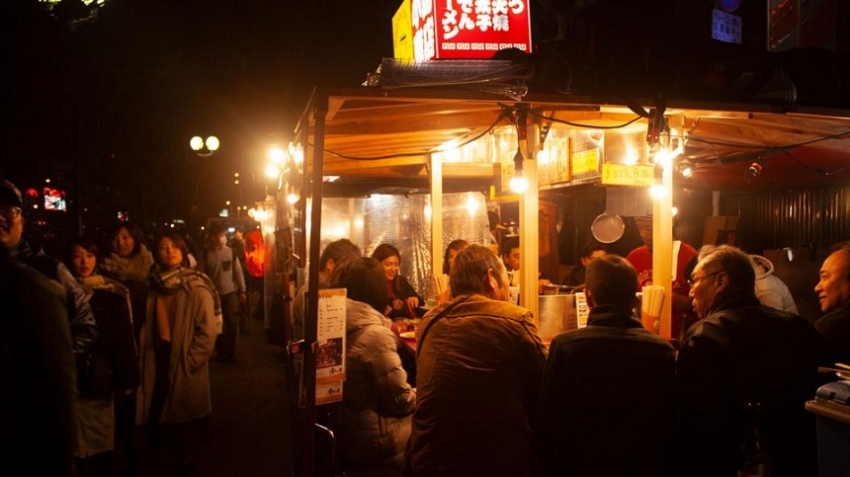Street stalls serving bowls of food were once common across Japan, but have declined in many parts of the country. In Fukuoka, however, yatai are finding new life as they evolve in the 21st Century.
On the pavement outside a nondescript office building in the heart of Fukuoka’s glass and concrete city centre is a little pocket of a world gone by.Behind tarpaulin sheets designed to keep the chill winter air out customers sit cheek to jowl on battered wooden benches around Mamichan’s miniature kitchen. A steaming vat of oden – a Japanese hotpot – fills the tiny space with a savoury aroma that mixes with the smoke from a small coal grill covered in sizzling yakitori meat skewers.
This is one of the yatai – portable restaurants that were once common across Japan but have declined in many cities. In the south-western city of Fukuoka, however, they still survive. Each one folds up into a hand-pulled cart that their owners can wheel to their designated pitch six nights a week, where they unfurl to create a uniquely intimate dining experience.
Innovative new takes on what a yatai can be are bringing in a new generation of customers
Even in this, one of the final bastions of the yatai, their numbers have been steadily declining. In the 1960s there were roughly 400 but today that number has shrunk to less than 100. Just like in the rest of the country, successive local governments sought to clamp down on what were seen as noisy and unsightly late-night eating spots that disturbed residents and created litter.
But growing recognition of the pull this distinctive culinary tradition has on tourists both from Japan and abroad has seen that start to change. In 2016, the first new licences in decades were awarded after the city’s mayor decided to champion the yatai. And innovative new takes on what a yatai can be are also bringing in a new generation of customers as word spreads on Instagram and food blogs.
Customers gather around a yatai stall (Credit: Edd Gent)
Punters peruse the many yatai found lining the canal in Fukuoka's city’s nightlife district of Nakasu (Credit: Edd Gent)
The 56-year-old Mamichan clearly enjoys her job, chatting away jovially with customers as she cooks and serves drinks at her eponymous yatai, but she tells me it wasn’t always that way. Her husband, with whom she works alongside their 31-year-old son, bought the yatai without asking her when she was just 23 and she had little choice but to pitch in.
Running a yatai is tough work – most open around 6pm and don’t shut until 1am. After closing the yatai needs to be cleaned, packed up and wheeled to its storage spot and most of the day before is spent preparing food.
“At first the motivation was just a way to raise a kid, I didn’t like it,” says Mamichan. “There were many young people the same age as me, they were really fashionable and playing around and I thought, 'Why is it only me doing all this?’”
Over the years though she says she’s developed a sense of pride in her job and a growing appreciation for the great diversity of humanity to which her yatai has exposed her.
"I can meet many people including people from outside Japan from many countries,” she says. “It makes me feel just like I have visited many countries so I don't have to travel around myself."
Three women choose their dishes at a yatai stand (Credit: Edd Gent)
Eiji Abe prepares food at his yatai Maruyoshi. He argues that yatai are informal spaces that allow people to let down their guard with strangers (Credit: Edd Gent)
As we eat, Mamichan gets up to bid farewell to three guests – a young man from Tokyo and two young women from Osaka who have struck up a quick friendship over shared beer and steaming bowls of ramen before heading off into the night together.
"That's the spirit of the yatai," says my guide and translator for the evening Toshihiro Mori, from the city’s tourism department. "People pick up some of the friendliness of Fukuoka.”
Why such a seemingly important social institution has largely disappeared from Japan is up for debate
Everyone I speak to highlights the social lubrication the yatai provides, a welcome break from Japanese society’s stiff formality. Packed into such a tight space and loosened up by free-flowing beer and shōchū – a local spirit popular in the southern island of Kyushu – people feel able to let down their guard.
"It's not only communicating with the man in the yatai but also communicating with the other customers – that is the attraction of the yatai,” says Eiji Abe, 49, who runs a yatai called Maruyoshi. “Of course many customers come just to drink or for food but many people like to communicate.”
Why such a seemingly important social institution has largely disappeared from Japan is up for debate. Theories abound, says Eiji, from the American occupying powers ordering their closure after World War Two; to officials seeking to tidy cities up as the Emperor toured the country following the War; to the changing nature of Japan’s streets as growing numbers of cars squeezed the yatai out.
Their survival in Fukuoka is largely put down to owners being quick to organise into a union, but even here they’ve been squeezed. A 1995 law prevented the establishment of new yatai or passing licences to anyone other than a direct relative. The yatai street in the city’s north was also shut down in favour of government-sanctioned pitches dotted around the city.
A smiling stall holder hands his happy customers a plate of food (Credit: Edd Gent)
Kensuke Kubota serves customers at his yatai Telas & Mico (Credit: Edd Gent)
It’s not just regulation to blame though, says Kensuke Kubota, 40, who runs a yatai called Telas and Mico. Changing attitudes are also at play, he says, particularly among younger generations where yatai are seen as a place for older people and drunken businessmen.
“Young people think yatai are not so cool,” says Kubota. “But I'm going to show the young generation, maybe change the minds.”
The clean minimalist design of his turquoise and pine yatai would look more at home in Borough Market and is paired with a menu straight out of a British gastropub – homemade sausages and mash, bruschetta and tandoori chicken skewers.
That makes more sense when you discover Kubota started his culinary training in a fish and chip shop in Plymouth while on a language exchange. Spells at a series of Michelin star restaurants in London completed that education, and when he moved back to Fukuoka he opened a restaurant. A few years later when he heard the government was accepting new yatai licenses he was immediately sold.
“I used to go with my father to yatai so many times,” he says. “But I didn't want to make a traditional yatai. I wanted to make a new style one. I wanted to change the way people think about yatai.”
He seems to be having some success. A trendy-looking man in his thirties takes a seat opposite me and immediately starts joking with Kubota, who tells me he’s a regular. He’s an advertising designer and says he was drawn to the fresh look of the yatai and now comes weekly. A few minutes later, he’s joined by two equally fashionable young women who started coming after seeing the yatai on Instagram. When I ask if they go to more traditional yatais, the reply is a resounding "no".
Frenchman Remy Grenard puts a Gallic twist on yatai (Credit: Edd Gent)
One of Remy Grenard's assistants serves customers at Chez Remy, which serves French bistro food (Credit: Edd Gent)
Kubota isn’t the only one breaking the mould. Frenchman Remy Grenard, 42, is Fukuoka’s first foreign yatai owner serving the kind of dishes you’d expect to find in a French bistro – escargots are the crowd pleaser he says. He’s lived in Japan for 18 years and previously owned a restaurant and bakery in Fukuoka, but when the city started taking new yatai applications a friend encouraged him to apply.
Initially he only did two days a week, but when the yatai got busy it wasn’t a tricky decision to close his other businesses and go full-time at his yatai Chez Remy. “I love to cook and I love to meet people,” he says, and a yatai lets him do both at the same time.
The combination of his bubbly personality and reasonably priced Gallic delicacies has gone down well in a country where French restaurants are typically high-end affairs. Ultimately though, he says the menu is not the heart of any yatai.
“The food is not important,” he says. “The most important is that people feel good in Fukuoka.” To borrow a phrase from his mother tongue the yatai are all about the “bonhomie”.
Remy tells me I won’t fully understand the yatai until I visit one alone
His customers agree. Takeharu, 51, and Kaori, 50, Sugawara who live in Fukuoka say they go to yatai fairly regularly, normally taking in one or two in a night both traditional and more modern. “It's easy to make connections,” says Kaori. “You meet many good people so it's heart-warming.”
Remy tells me I won’t fully understand the yatai until I visit one alone, so I take his advice. It doesn’t take long to see what he means. As I step in off the street, I’m greeted warmly by the proprietors who quickly offer me a drink, and it doesn’t take long before the group of young women sat next to me strike up a conversation in slightly broken English. They switch seamlessly back and forth from English to Japanese, joking with the owners and translating their questions for me.
But while increased support from the government and the entry of new yatai has breathed fresh air into a struggling industry, you can’t help but wonder if this revitalisation will see them lose their community roots and become increasingly indistinguishable from the trendy pop-up street food found in every cosmopolitan city.
Mamichan says years ago customers were mainly regulars and business people, but in recent years tourists both from Japan and neighbouring countries like China and South Korea have come to make up the bulk of visitors. "Sometimes regular customers come in and we're so busy with tourists that they can’t sit,” she says. “It's a big change."
A woman browses between the colourful stall fronts (Credit: Edd Gent)
Yatai in Ofunato, an area devastated by the 2011 tsunami. The street food "villages" are popular among tourists and locals (Credit: Getty Images)
She loves to meet new people but the spirit of the yatai is not only about a genial atmosphere, says Mamichan, but also about building relationships. She might give a customer a free meal when he’s hard up, but he’ll come back and spend money there when he has it. Some of the newer yatai, she feels, are becoming more like conventional restaurants.
It’s easy to see this in the city’s nightlife district of Nakasu. Reps try to sweet-talk tourists into the yatai lining the side of the canal, and queues form outside the most popular despite it being well out of season. I’m told by several people that yatai can be big money spinners, particularly if you can keep customer turnover high.
Kubota feels there are parallels with Britain’s struggling pubs, where changing attitudes among younger generations have seen the demise of the local being packed with regulars every night. But at the same time he takes inspiration from the rise of gastropubs in the UK and he thinks Fukuoka’s yatai need a similar update to keep pace with current preferences. He hopes to see more innovative proposals next time the government accepts new applications.
“Not everything has to change but you have to do something new,” says Kubota. “It's not going to be the death of the traditional yatai, but the idea has to be successful with a new generation.”
And it’s not a zero sum game with yatai, says Remy. The Japanese have a broad palate and people typically visit several in a night so a bit of diversity doesn’t harm anyone, and in fact could pull in customers who wouldn’t typically think of going to yatai, he says.
“Customers change, people change,” he says. "The traditional ones are very important, but now we make the next tradition of the yatai.”




















